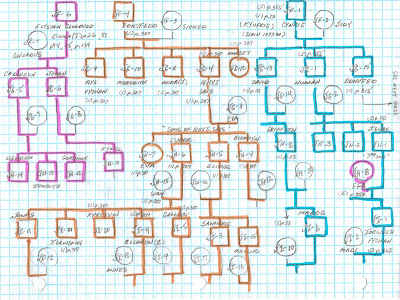Next in line down my Jones surname family tree is Cynwrig (JF-1) [which is also spelled Cynrig, and Kynfrig]. "Flop, flop...fizz, fizz...oh, what a relief it is" echoes down the hallways of my memory when looking into the windows of this distant grandfather. His father Rhiwallon (JE-1) had occupied the family lands of his father Dingad (JD-3), which then would be passed down the branches. However, many changes had occurred to the unity and cooperative spirit accomplished during the life of Hywel Dda [ca. 880 A.D. to 950 A.D.]. The sons of this father-in-law to Tudor Trevor (JC-1), ironically, by the laws just assembled and written [ca. 940s A.D.], wanted their inheritance equally divided. In addition, all the maternal side of the relatives [Nest of Powys 855 A.D., Anghard of Seisyllwg 871 A.D., and Elen of Dyfed 905 A.D.] all wanted their slice of the pie. Added to all this, the Vikings had started their raids, the Mercians wanted to take back the land reclaimed by those of Powys, and all the first, second, and their cousins wanted their wishes known. No wonder the antiacids would be needed on most days since you would not be sure who would show up at your door with their swords drawn.
Now Cynwrig (JF-1) labeled "Chieftain of Powys", and his wife Judy (JF-2) named of Rhos, seemed to have managed these years [c. 1025 - 1073 A.D.] fairly well. Their seven children born after 1040 A.D., would have taken roughly 14 years of these 30 some years. The three daughters Gwenllian (JG-28), Arddyn (JG-30), and Jane (JG-32) must have been the oldest because all four boys, Ninnian (JG-1), David (JG-3), Ednyfed (JG-15) and, Hwvm (JG-17) would have to be younger than age 14 at the time of the death of their father in 1073 A.D. It is stated that Cynwrig (JF-1) was slain by the men of Gwynedd and, it was also recorded that the sons of Rhys Sais (JG-4) took our family's blood-feud back to Gwynedd by killing Gwrgenau ap Seisyll in 1081. If any of the sons of Cynwrig (JF-1) had been older then 14 and, had their military training by 1081, they would have taken revenge into their own hands. Needless to say, the sons of Tudor Trevor (JC-1) were still working together before that huge storm cloud that was forming on the other side of the Island blew its way over my ancestor's town-lands.
For a big picture of the day, the following figure shows my kindred from the top of the family tree.
Gadforch (JA-1) to Ynyr (JB-1), to Tudor Trevor (JC-1) to Dingad (JD3), to Rhiwallon (JE-1), and finally to Cynric (JF-1) shows my branch of this rapidly growing kindred group. [outlined in blue] The other sons of Tudor Trevor (JC-1); Llydocka (JD-2) [outlined in orange], and Gronwy (JD-1) [outlined in pink] are shown in their position to my baby brother's branch.
The next diagram continues these branches down the tree, showing the relationship of the sons of Rhys Sais (JG-4) to the branches of Cynrig (JF-1). You can see the generational differences because of the passage of time, the age of children, and the story being told, given through the windows of history.
P.S. The name Rhys Sais suggest that he could speak English, and would have played a special roll in the events of the day. The references used to document all above are given in the posts of April 9th, and May 3rd.
.jpg)
.jpg)
.jpg)
.jpg)


.jpg)